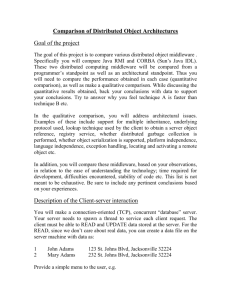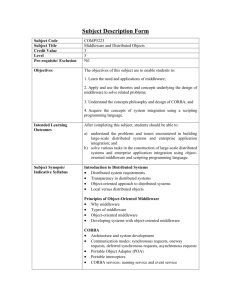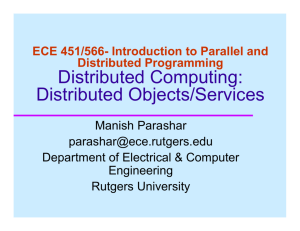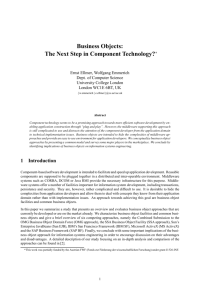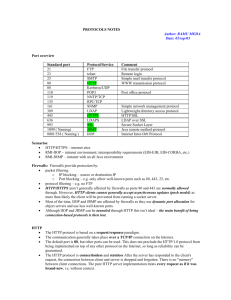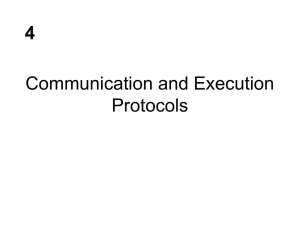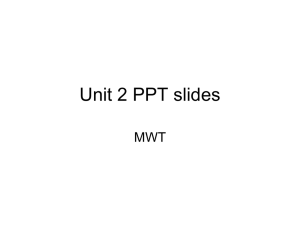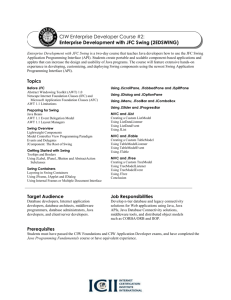Aglets Runtime Layer: The Aglets runtime layer implements Aglets
advertisement
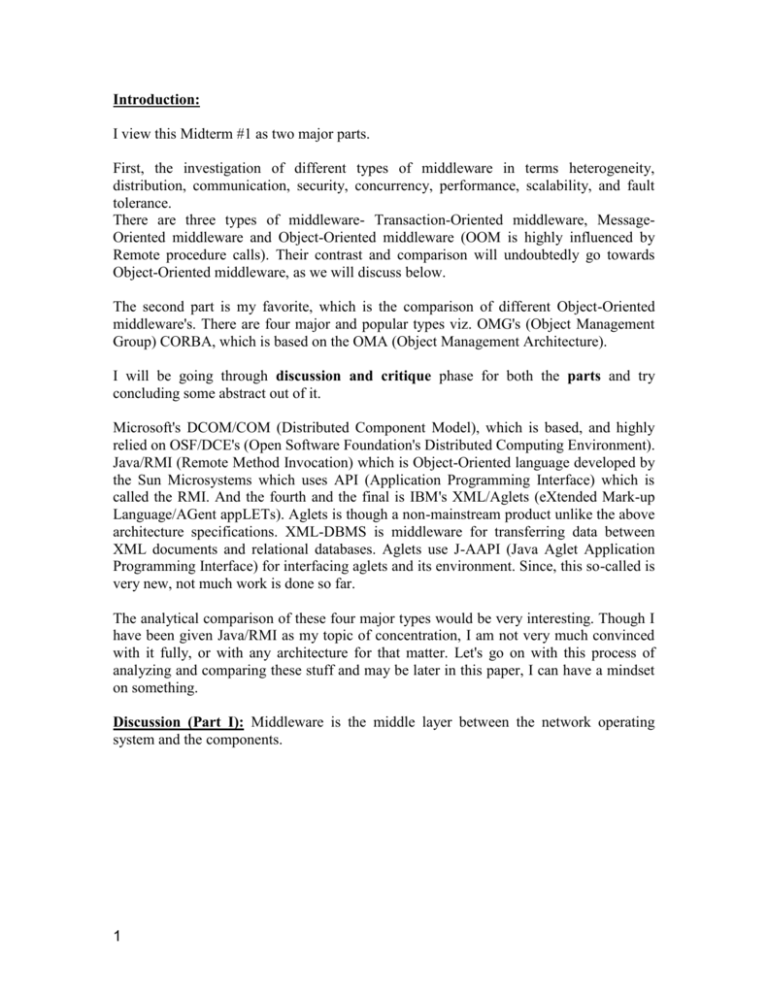
Introduction: I view this Midterm #1 as two major parts. First, the investigation of different types of middleware in terms heterogeneity, distribution, communication, security, concurrency, performance, scalability, and fault tolerance. There are three types of middleware- Transaction-Oriented middleware, MessageOriented middleware and Object-Oriented middleware (OOM is highly influenced by Remote procedure calls). Their contrast and comparison will undoubtedly go towards Object-Oriented middleware, as we will discuss below. The second part is my favorite, which is the comparison of different Object-Oriented middleware's. There are four major and popular types viz. OMG's (Object Management Group) CORBA, which is based on the OMA (Object Management Architecture). I will be going through discussion and critique phase for both the parts and try concluding some abstract out of it. Microsoft's DCOM/COM (Distributed Component Model), which is based, and highly relied on OSF/DCE's (Open Software Foundation's Distributed Computing Environment). Java/RMI (Remote Method Invocation) which is Object-Oriented language developed by the Sun Microsystems which uses API (Application Programming Interface) which is called the RMI. And the fourth and the final is IBM's XML/Aglets (eXtended Mark-up Language/AGent appLETs). Aglets is though a non-mainstream product unlike the above architecture specifications. XML-DBMS is middleware for transferring data between XML documents and relational databases. Aglets use J-AAPI (Java Aglet Application Programming Interface) for interfacing aglets and its environment. Since, this so-called is very new, not much work is done so far. The analytical comparison of these four major types would be very interesting. Though I have been given Java/RMI as my topic of concentration, I am not very much convinced with it fully, or with any architecture for that matter. Let's go on with this process of analyzing and comparing these stuff and may be later in this paper, I can have a mindset on something. Discussion (Part I): Middleware is the middle layer between the network operating system and the components. 1 Fig. 1 Middleware in Distributed Systems In the figure, it's seen that the middleware sits between the Network Operating Systems and the components to solve the problem of heterogeneity and distribution. Distributed system constructed directly on the top of a transport layer is difficult therefore we use object-oriented middleware to resolve this issue. Middleware simplifies distributed systems construction by implementing the presentation and session layers of the ISO/OSI reference model. To go into little more detail, middleware these vary important things among others. It maps complex parameters passed to service requests into a transmittable form; resolves heterogeneity; resolves logical component address to Internet domain names and port address; and synchronize client-server objects. The available middleware can be divided into three major categories: Transactionoriented, Message-Oriented and Object-Oriented Middleware. Let me go over these in detail and try comparing/contradicting each other. Lets find out why I feel object-oriented middleware is better than others. Transaction-Oriented Middleware: This supports the integration of transaction across distributed databases. The systems in this category include, IBM's CICS, BEA's Tuxedo and Transare's Encina. They are used where components are database applications. They use 2-phase commit protocol to implement distributed transactions. They are capable of integrating updates in distributed databases and provide the foundations for faulttolerance and load balancing. They use distributed transactions to maintain replicated databases on different servers. Updates to these databases are synchronized using distributed transactions. Load balancing is used to direct queries to least-loaded replica. This system is scalable too as many transactions can processed and many databases can be networked in this distributed schema. A transaction follows ACID (Atomicity, Consistency, Isolated, Durability) properties. This means that the transaction is performed completely or not at all, thus each state are consistent to one another, it is executed isolation with one another and after completion they are durable. The combination of consistency and durability means that the transactions are stored in a persistent way. The combination of atomicity and consistency means that a transaction can always be recovered. The combination of isolation and consistency means that no non-concurrent can see any inconsistent information in the course of a transaction. The combination of consistency and durability means that the 2 information storage is persistent. The problems deadlocks and the livelocks are solved using some techniques, thus making the system fault-tolerant. Two major problems of concurrency controls: lost updates and inconsistent analysis are taken care of. Concurrency control is transparent to client designers but is not transparent to server designers. All transactions are Serializable i.e. results of serialization is same as when done by sequential order. Concurrency control manager detects deadlocks and they are resolved by aborting the transaction, which is involved in the deadlock. The two-phase commit protocol consists of a voting phase and an implementation phase. In voting phase, the transaction coordinator checks whether every participant transaction server is able to commit the transaction. During commit, the servers save their changes to persistent storage and thus implements durability. The phase after the commit and receiving of the commit request is called server uncertainty. It has to be covered by storing the modifications of the transaction on temporary persistent storage. The Open Group has adopted a standard for Open Distributed Transaction Processing (DTP). The latest standard is called The X/Open DTP standard. This architecture defines application programming interfaces and interactions among transactional applications (APs), transaction managers (TMs) and resource managers (RMs). The architecture is drawn is the diagram as in Figure 2. Fig 2. Transaction-Oriented Middleware Architecture 3 These distributed object transactions build on the XA-Protocol of the DTP standard are available in object-oriented middleware too. Object-oriented middleware provides services for the implementation of transactions, the CORBA Transaction service, MTS (Microsoft Transaction Server) and the Java Transaction API. Message-Oriented Middleware: These middleware systems enable the exchange of reliable message traffic across distributed components. Some of the products for this middleware are: IBM's MQSeries, the DEC message Queue, Sun's ToolTalk, NCR's ToEnd or the Java Message Queue. Message-Oriented middleware is used when reliable, synchronous and asynchronous communication is the dominant form of distributed system interaction and is event driven rather than procedure driven. Fig3. Message Oriented Middleware architecture They support communication between distributed systems components through message exchange. The greatest thing is that it supports asynchronous message delivery very easily and elegantly. The client continues to process as soon as the middleware grabs the message. The server sends the message result to the client, which it collects at an appropriate time. This de-coupling of client/server leads to a more scalable system. Data is exchanged by message passing and/or message queuing supported by both synchronous and asynchronous interactions between distributed computing processes. The MOM system ensures message delivery by using reliable queues and by providing the directory, security, and administrative services required to support messaging. The second big advantage is able to multi-tasking i.e. passing the same message to multiple clients in a way it seems transparent to the client. This is very useful in implementing event notification and publish/subscribe-based architectures. The MOM achieves fault-tolerance by implementing message queues that store message temporarily on persistent storage. Object-oriented middleware initially did not supported fault-tolerance and used only synchronous way to communicate with the objects with atmost-once semantics (Errors is passed, if requests is failed. Otherwise, do nothing). The biggest difference between MOM and object-oriented middleware is: 4 MOM supports messages and therefore is primarily designed to support deferred communication while peer-to-peer and remote procedure calls (RPC) are designed to support synchronous communication. Under RPC, the receiving server must be available to accept messages sent. If the server is down, the message cannot be delivered at that time. MOM, on the other hand, can send messages to servers that are down without having to resend them. Messages under a MOM system are placed into a queue and retrieved whenever the server requests them. Whether the server is available at the time the message is sent is irrelevant. But now, the integration of MOM and OOM make it possible to achieve reliable and asynchronous message requests. Object-Oriented Middleware: Remote procedure calls (RPC) were standardized by the OSF, which supported the invocation of procedures across boundaries. They were developed by sun Microsystems as a part of their Open network Computing (ONC) platform. Object-oriented middleware has its basis and was very much influenced with the RPC's. Examples of the products may include popular mainstream products such as CORBA, Java/RMI, (D)COM and some non-mainstream products such as Aglets, implementation of tuple spaces that distributed threads can use to communicate and others unpopular ones. The idea was to make the principles of object orientation such as identification through references and inheritance available for distributed systems. The object-oriented middleware contains all aspects of above of middleware architecture, plus it implements the idea of object-orientation, which makes it a really cool specification. Fig 4. Object-Oriented Middleware 5 Interface Definition Language: Every OOM has an IDL. IDLs are language constructs to which help in communicating between different environments. Thus, OOM systems support heterogeneity. IDL supports the concepts of object types as parameters; failure handling; and inheritance. IDL has language constructs for all concepts of the respective object models. There are 2 main disadvantages to RPC's. First, they are not reflexive i.e. Procedures exported to by one RPC program cannot return another RPC program. Second, RPC does not handle in an amicable way; they return null pointers whenever error is encountered. These 2 disadvantages are removed in OOM. OOM are fault-tolerant, as they handle failures in a real sophisticated manner using atmost-once semantics. It uses exception to tell clients about the details of the failures. Session-layer Implementation: This layer is little complex than RPC layer. Session layer needs to map object references to hosts. Session layer uses object adapters to locate server objects and to activate/deactivate them when ever needed. Object adapters need to start up the server, which register in an implementation repository or registry. Session layer needs to implements operation dispatch and synchronization. Server and Client Stubs generation: They perform (un)marshalling for the transport layer and revolve the problem of heterogeneity of data representation. This constitutes presentation layer implementation. Client and server stubs are derived from interfaces. Stubs are generated to implement session and presentation layers. Object requests which are executed remotely uses marshalling and un-marshalling of parameters to resolve the heterogeneity and the synchronization of client/server objects. In RPC, a hardware stack does the parameter passing. Implementation of client objects: It follows static request definition i.e. request is fully defined at the time when source code is compiled. Object requests have always has to be type-safe i.e. the requests promised at the compile time should be similar to that the runtime. Stubs have access and location transparency though it depends if the architecture is CORBA, RMI or COM. Implementation of server objects: Like the client objects, the server objects supports type-safe (no run-time errors). Type safe can be implemented in 2 ways: Inheritance, middleware develops an abstract class for the server stub. This abstract class has abstract operations but is not implemented by the class. The class implementing this server object is defined as the subtype of this abstract class. Server stub is statically referenced to the abstract class. The server stub is dynamically referenced to the server object. Second approach is using interfaces. The IDL generates a programming language interface that includes all operations exported by the IDL interface. The approach achieves type-safety as the compiler used for translating the implementation of the server object checks that it correctly implements the interface that was derived by the IDL compiler. 6 Server Registration: Once the server object is compiled, it needs to be registered with the object-oriented middleware. The purpose of registration is to help the object adapter to locate the reference of the server objects and to (de)activate them as and when needs. Critique (Part I): Lets have a comparison of these three middlewares on the basis on heterogeneity, distribution, communication, security, concurrency, performance, scalability, and fault tolerance and find out why OOM is better than other middlewares in most of the scenarios. Transaction Middleware: Network Communication: Transactional middleware enables application engineers to define the services that server components offer, implement those server components and then write client components that request several of those services within a transaction. Client and server components can re-side on different hosts and therefore requests are transported via the network in a way that is transparent to client and server components. Coordination: The client components can request services using synchronous or asynchronous communication. Transactional middleware supports various activation policies and allows services to be activated on demand and deactivated when they have been idle for some time. Activation can also be permanent, allowing the server component to always re-side in memory. Reliability: A client component can cluster more than one service request into a transaction, even if the server components reside on different machines. In order to implement these transactions, transactional middleware has to assume that the participating servers implement the two-phase commit protocol. If server components are built using database management systems, they can delegate implementation of the twophase commit to these database management systems. For this implementation to be portable, a standard has been defined. DTP is widely supported by relational and object oriented database management systems. This means that distributed components that have been built using any of these database management systems can easily participate in distributed transactions. This makes them fault-tolerant, as they automatically recover to the end of all completed trans-actions. Scalability: Most transaction monitors support load balancing, and replication of server components. Replication of servers is often based on replication capabilities that the database management systems provide upon which the server components rely. Heterogeneity: Transactional middleware supports heterogeneity because the components can reside on different hardware and operating system platforms. Also different database management systems can participate in transactions, due to the standardized DTP protocol. Resolution of data heterogeneity is, however, not well supported by transactional middleware, as the middleware does not provide primitives to express complex data structures that could be used as service request parameters and therefore also does not marshal them. The above discussion has shown that transactional middleware can simplify the construction of distributed systems. Transactional middleware, however, has several weaknesses. Firstly, it creates an undue overhead if there is no need to use transactions, or transactions with ACID semantics are inappropriate. Secondly, marshalling and un-marshalling between the data structures that a client uses and the parameters that services require needs to be done manually in many products. Thirdly, 7 although the API for the two-phase commit is standardized, there is no standardized approach for defining the services that server components offer. This reduces the portability of a distributed system between different transaction monitors. Message-Oriented Middleware Network Communication: Client components use MOM to send a message to a server component across the network. The message can be a notification about an event, or a request for a service execution from a server component. The content of such a message includes the service parameters. The server responds to a client request with a replymessage containing the result of the service execution. Coordination: The strength of MOM is that this paradigm supports asynchronous message delivery very naturally. The weakness, at the same time, is that the implementation of synchronous requests is cumbersome, as the synchronization needs to be implemented manually in the client. A further strength of MOM is that it supports group communication by distributing the same message to multiple receivers in a transparent way. Reliability: MOM achieves fault-tolerance by implementing message queues that store messages temporarily on persistent storage. The sender writes the message into the message queue and if the receiver is unavailable due to a failure, the message queue retains the message until the receiver is available again. Scalability: MOMs do not support access transparency very well, because client components use message queues for communication with remote components, while it does not make sense to use queues for local communication. This lack of access transparency disables migration and replication transparency, which complicates scalability. Moreover, queues need to be set up by administrators and the use of queues is hard-coded in both client and server components, which leads to rather inflexible and poorly adaptable architectures. Heterogeneity: MOM does not support data heterogeneity very well either, as the application engineers have to write the code that marshals. With most products, there are different programming language bindings available. In assessing the strengths and weaknesses of MOM, we can note that this class of middleware is particularly well-suited for implementing distributed event notification and publish/subscribe-based architectures. However, message-oriented middleware also has some weaknesses. It only supports atleast once reliability. Thus the same message could be delivered more than once. Moreover, MOM does not support transaction properties, such as atomic delivery of messages to all or none receivers. There is only limited support for scalability and heterogeneity. Object Oriented Middleware Network Communication: Object middleware support distributed object requests, which mean that a client object requests the execution of an operation from the server object that may reside on another host. The client object has to have an object reference to the server object. Marshalling operation parameters and results are again achieved by the stubs that are generated from an interface definition. Coordination: The default synchronization primitives in the object middleware are synchronous requests, which block the client object until the server object has returned 8 the response. However, the other synchronization primitives are supported, too. CORBA 3.0, for example, supports both deferred synchronous and asynchronous object requests. Object middleware supports different activation policies. These include whether server objects are active all the time or started on-demand. Threading policies are available that determine whether new threads are started if more than one operation is requested by concurrent clients, or whether they are queued and executed sequentially. CORBA also supports group communication through its Event and Notification services. This service can be used to implement push-style architectures. Reliability: The default reliability for object requests is at-most once. Object middleware support exceptions, which clients catch in order to detect that a failure occurred during execution of the request. CORBA messaging, or the Notification service can be used to achieve exactly-once reliability. Object middleware also supports the concept of transactions. CORBA has an Object Transaction service that can be used to cluster requests from several distributed objects into transactions. COM is integrated with Microsoft’s Transaction Server, and the Java Transaction Service provides the same capability for RMI. Scalability: The support of object middleware for building scalable applications is still somewhat limited. Some CORBA implementations support load balancing, for example by employing using name servers that return an object reference for a server on the least loaded host, or using factories that create server objects on the least loaded host, but support for replication is still rather limited. Heterogeneity: Object middleware supports heterogeneity in many different ways. CORBA and COM both have multiple programming language bindings so that client and server objects do not need to be written in the same programming language. They both have a standardized data representation that they use to resolve heterogeneity of data across plat-forms. Java/RMI takes a different approach as heterogeneity is already resolved by the Java Virtual Machine in which both client and server objects reside. The different forms of object middleware interoperate. CORBA defines the Internet Inter-Orb Protocol (IIOP) standard, which governs how different CORBA implementations exchange request data. Java/RMI leverages this protocol and uses it as a transport protocol for remote method invocations, which means that a Java client can perform a remote method invocation of a CORBA server and vice versa. CORBA also specifies an inter-working specification to Microsoft’s COM. Object middleware provides very powerful component models. Discussion (Part II): Now that we have establish a deal in the object-oriented middleware. Lets see and compare the different Object oriented middleware products (CORBA/COM/RMI/Aglets) in terms of specifications, Meta-object model, objects, types, attributes, operations, requests, failure handling, Multiple Inheritance (Sub-typing), polymorphism, stubs & skeletons, object activation, and architecture. I believe this comparison would be quite interesting. OMG's CORBA: 0. Assumption: Servers stubs are called the server skeletons in CORBA. IDL compiler generates 4 files - two for client stubs and two for server stubs. For each, one is class definition and other is class implementation. 9 1. Specification: There are four different types of OMG (Object Management Group) specifications. a. OMA (Object Management Architecture) - It has a reference model for distributed objects and classifies objects into different categories. b. CORBA (Common Object Request Broker Architecture) - This is the most popular OMG architecture. CORBA supports heterogeneous and distributed objects. Communication between objects is achieved through an ORB (Object Request Broker). It has an IDL (Interface Definition Language). It identifies a number of programming binding (how client-server objects can be implemented in different programming languages). It also has object adapters where is executable code object and to activate/deactivate them). c. CORBAservices Specification: It is a basic mechanism that enables the construction of distributed systems. We have almost a dozen services like locating objects, creating & moving objects, push-type communication between objects, managing relationships between objects, controlling concurrent access to objects, managing distributed transactions between objects, securing access to objects etc. d. CORBAfacilities Specification: They have interfaces for distributed help systems and a facility for operating systems independent printing & spooling. 2. Meta Object Model: The object model uses IDL (Interface Definition Language). OMG has various standard languages binding between IDL and other OO programming language. 3. Objects: It has a unique object identifier. Object references are opaque to clients (i.e. they do not know the content). Object references support location transparency (i.e. they do know/care for the location of the invoking object). Physical hostname is embedded to enable CORBA implementation to locate the server objects, but this information is hidden from client. Object references are managed by ORBs. The broker stores it all time even if that object might be currently deactivated. 4. Types: CORBA object model are statically typed as it enables type-safety. Object type has a unique name. Complex types can be constructed using type construction mechanism. Interfaces name should be unique The concept of modules (which are declared in IDL) can have nested modules. They have a concept of scoped identifiers (access for declaration types to other modules). They are defined in CORBA IDL. 5. Attributes: CORBA Object model have a concept of attributes (use to make the state of server accessible to clients). Attributes are treated as operations. Attributes are defined in CORBA IDL using keyword Attribute. Attribute type has to be known. 10 CORBA object model uses interface definition. Thus, they don't need public/private attributes. All attributes are accessible to clients. Hidden attributes as not declared in IDL but are in object type implementation. It supports the idea of read-only attribute. It supports the idea of constants. They are read-only attributes and not even changed by server object implementation. 6. Operations: CORBA object model support idea of operations (for object types). An operation has a return type an operation name, list of parameters and a list of exceptions. Does not believe in public/private operations. Everything is available to the client object. The operations that are not supposed to be made available to clients are not declared in the interface of the object request. Operations can have three different parameters: 1. 'in' : Clients submits an actual value not modified by the server. 2. 'out' : Server object has produced a parameter value during the object request. 3. 'inout' : The client passes the actual parameter value that is modified by the server during the required execution. Explicit parameters kinds used for signal memory allocation and de-allocation, obligation to client-server programming. No overloading concept because it makes IDC more complex. 7. Requests: A request in the CORBA object model identifies server object by an object reference to that object. It also has name and the actual parameters of the requested operations. They might also pass information about the environment in which they are executed. Definition of requests can be for compile time (static request) and for run time (dynamic request). Static request can be determined by invoking by invoking a client stub and dynamic request by using a standardized dynamic invocation library. Object requests have at-most-once semantics (i.e. an error is indicated to the client if the requested is not executed at the server). 8. Failure handling: CORBA has 25 or more exception handlers to inform client about failures. They are raised by ORB's when errors occurs. 9. Multiple Inheritance: CORBA object model supports multiple inheritances. Inheritance is public (i.e. all subtypes of the attributes are exported). Inheritance is virtual (Operations are bound dynamically and what is used to implement an operation is only decided at run-time). Multiple inheritance might lead to clashes and is up to the designer to resolve them. The inheritance hierarchy has a predefined single root called interface object. 11 10. Polymorphism: CORBA attribute/variable has a static type (which is defined at run-time). CORBA object has a dynamic type (the object type for which the object was initiated). CORBA object model supports a restricted type of polymorphism (i.e. attributes whose static type is an object type may refer at run-time to objects which are of different types). In short, dynamic types have to be subtypes of the static types. Polymorphism is used with redefined types (i.e. they are restricted with operations). It is not possible to redefine the static type of an attribute. The signature of an operation cannot be changed. This ensures "type-safe". 11. Architecture: The Figure 5 shows a detailed CORBA architecture. Fig5. The CORBA Architecture [Note: IDL are same as client stubs; IDL skeleton and Dynamic Skeleton are also called Object Implementation] a. ORB Core: It is the central component of the CORBA architecture. It receives a request from the client based on reference provided by the client. It passes all parameters to server and returns results to the client object. b. Server Stubs: Marshalling and un-marshalling of request parameters are done by servers stubs (comprise of dynamic invocation, client stub and implementation skeleton). c. Client Stubs & Server Skeleton: They are generated by IDL compiler. d. Dynamic Invocation: It supports the definition of requests at run-time. e. Object Adapters: Two major types: 12 BOA (Basic object adapter): It defines the registration of server objects with an ORB. It generates references for server objects and are responsible for their activation & de-activation. POA (Portable object adapter): It responsible for registration, activation/deactivation of server objects and also support responsible objects. f. ORB Interface: A set of types that both client/server objects for initialization purposes. g. CORBA ORB: It achieves access transparency (client stubs has exactly the same interface as server stubs). It achieves location transparency (all client object needs to know just the reference of the server objects). It also supports other types of transparencies when used with CORBAservices. Sun Microsystems's Java/RMI: 0. Assumption: Since this technology is exclusive java it is assumed to possess all the properties that java has like, it is portable. It is a hybrid language i.e. can be both compiled and interpreted and so on. It assumes that both client/server are written in java and executes in a java VM. Even before RMI, java has included distinction between interfaces and classes. 1. Specification: [Java] Java is an OO language developed by the Sun Microsystems. Java compiler creates a byte stream, which is interpreted by the virtual machine. The communication between two objects on different VM (virtual machine) could be done through JDK1.1+. [RMI]: Java includes an API (Application Programming Interface) known as Remote Method Invocation. It enables the invocating of client object from one VM to call the server object on another VM. Its design includes object communication, integration with java object model and for resolution of heterogeneity. It includes abstraction of UDP datagrams and TCP streams. Sun has provided some high level services on top of RMI like, JINI (It supports application constructs for portable hosts like transaction and event-notification services. And EJB (It provides component based development by combining Java beans with RMI and adding services such as transactions, persistence and security). 2. Meta Object Model: No IDL is needed (client/server are in java). For restricting the visibility of declarations, there is a scooping mechanism called "packages". (This is similar to CORBA). There is need to identify the packages file to which the declarations exists. Declarations contained in other packages need to scoped with the package name. 3. Objects: Both client/server objects are in java and thus invoke each other. "Local procedure calls" are governed by class definition & RMI by Interfaces. 13 RMI does not support location transparency - Client object need to know the reference of the server object and the type (local or remote) call. The client object gets references from Java/RMI registry for server objects. This registry is based on the naming service (server objects bind there object through a name). 4. Types: It is strongly typed language. It has a static type system. It supports atomic types (they are int, float, double and char). Java object types includes both classes and interfaces. Server objects that wants to be accessible remotely needs to implement at least one interface. 5. Attribute: Interfaces cannot define attributes (for remote calls, the attributes has to be marshaled & transformed and attribute access may fail). It is similar to COM, in CORBA, they support as attributes are treated as operations). Thus, the designers of remote objects have to write access operations. 6. Operations: Operations in java are called methods. A client object can request execution of all those methods that are declared in all remote interfaces of server objects. Operations should only have atomic; non-remote object types; and remote interfaces. The mechanism for passing objects to a remote object is different from local procedure call. There is no location transparency unlike in CORBA. a. Parameter passing of atomic type: Call by Value (For both local and remote calls.) b. Object passing: Call by reference (For local calls.) c. Object passing: Serializable (Passed by Value) (For local hosts and for remote calls.) Client copy the object before passing. d. Object passing: Call by reference (For remote objects to remote method.) Object is copied but should be kept on the same host. Application designers should be aware of the following 3 scenarios. Scenarios: a. For non-remote objects to pass to remote object, we need to use serialize interface. We have to know object has to be passed to the remote method. b. When passing non-remote object to remote method, any changes made at remote method to the object will not reflect at the local end. c. When passing remote object to remote method, any changes made at remote object will be seen at the local end. 7. Requests: Objects requests in java are RMI. It supports at-most-once semantics requests like CORBA and COM. 14 Java only supports static RMI (i.e. Java RMI can only be defined at the time when client object is compiled). It does not support dynamic RMI as it does have reflection API. 8. Failure Handling: If failure occurs, java throws exception. Any interface that extends remote has to declare to throw RemoteException. Remote methods throw additional exceptions, which may be useful to developers. 9. Multiple Inheritance: Java supports inheritance. It does not support multiple inheritance for classes but supports MI for interfaces. Remote inheritance can inherit from remote and non-remote interfaces at the same time as long as remote interfaces are allowed to throw RemoteException error. 10. Polymorphism: Java supports polymorphism that is statically restricted by inheritance. It ensures type-safety (possible if static type is a supertype of static type to be assigned). With multiple interface inheritance, it became possible to have polymorphism between remote and non-remote objects. 11. Architecture: Figure 6. shows the RMI detailed architecture. 15 Fig6. RMI Architecture The client starts a RMI through a local method call to the client stub (clients stubs are similar to CORBA and interface process in COM, stubs are type-specific and include object all the remote methods that are available from the remote object on the server side). Clients obtain references of remote objects by means of naming through the RMI registry. The server can register their objects to the registry so that client stubs can locate them. During execution, activation interface call the object's constructor and enable the object to restore its state. Once the object is activated, the control is passed to the skeleton which invokes the desired remote method. a. Stubs & Skeleton: They are specific to the type of a remote server object that implements as RMI It does marshalling and un-marshalling of invocation parameters (implements presentation layer). It is generated by rmic compiler (they are not similar to IDL in CORBA and COM thus the byte code needs to be shipped to client instead of interface definition). They are partially location transparent (as client need to know of the invoking method is local or remote). b. Object activation: Object reference follows the concept of faulting tolenrance. It locates the server object and activates/deactivates them depending among the need. Microsoft's COM: 0. Assumption: COM is relied on OSF/DCE's RPC model. Com proxy is similar to CORBA client stub. 1. Specification: It is technology based on network/OLE, DCOM and ActiveX. Com follows Binary encapsulation (machine code representation in server objects are evolved independently of the client objects) and binary compatibility (machine of the C/S objects are developed in different in different environments). 2. Meta Object Model: It uses MIDL (Microsoft's Interface definition language). 3. Objects: It uses concepts of interfaces, implementation and classes. COM Interface: To communicate between C/S objects. They are type-level abstraction. Always starts with "I". They are 128-bit physical names referred to as UUID's (which is unique in time and space). COM Implementation: It is a class of programming language that implements one or many interface. Programming language binds to C++, VB and MS version of Java. These binding tell how to use MIDL. Instances of COM implementation are called COM objects. They are instances of classes in their respective programming languages. It does not support object references as in CORBA. Objects, here are identified by pointers to main-memory locations. Pointers are called interface pointers. Com Classes: They are named implementations that represent instantiable types. They expose one or several interface and often provide the principal mechanism to create or locate objects. 16 They are initiated in class objects and have to have atleast one class object. COM class has a unique physical name called as CLSID's. The Figure 7 shows the following relations: An implementation can be instantiated by several COM object which are referred in main memory. Class object instances of COM objects and they used to create/locate COM objects. COM object model distinguishes logical and physical identifiers. COM does not module a mechanism, as we needed in CORBA. Since no modules are used in COM, UUIDs and CUSID's are generated by 128-bit integers to the interfaces and object implementation. This is real cumbersome. Fig7. Relationship between interfaces, implementation and classes 4. Types: COM object model are statically typed, MIDL checks for any static semantic errors. Interface pointers are dynamic typed. COM supports base types and a number of type constructors. COM base types are atomic types and are defined in a platform neutral manner. There are fewer Type primitives in COM than in CORBA. COM supports 3 forms of arrays depending on it will be used in input/output parameters. 5. Attributes: Unlike CORBA, Com does not support the specification of attributes for interfaces. Instead, COM supports use of property operations. COM allows the use of [propget] and [propput] to obtain or modify an attribute. Some programming language bindings then map these operations to instance variables access and modifications. 6. Operations: 17 Like CORBA, COM does not have any primitives to define the visibility of operations. All operations that are declared in COM interface are available to clients. COM has flexible interface mechanism that can be used to provide client-specific views on COM objects. We use Multiple Inheritance to do this in CORBA. Operations can have parameters. [in] parameters are supplied by clients, [out] parameters are returned by the COM object to a client and [in,out] parameters are supplied parameters that are modified by the COM objects. 7. Requests: COM operations return a 32-bit integer that encodes whether or not operations have successfully executed or not. This is unlike CORBA. An object request in COM is an operation invocation. Like CORBA, COM operations invocations have at-most-once semantics. Like CORBA, COM supports static definition of requests when the client is compiled. It also supports dynamic definition of requests. 8. Failure Handling: COM handles failures by means of results of COM operations. COM includes predefined type HRESULT to successful or fault execution of operations. HRESULT is a 32-bit integer value that is returned from server to client objects. It has 4 fields: Severity code (indicates success by zero and error by one), reserved (internal use, not use c/s programmers), facility code (success or failures of Microsoft's technologies) and Information code (to pass error information). The good thing about HRESULT is that they are less expensive than exceptions in java or CORBA. 9. Inheritance: COM supports interface inheritance. One interface inherits from another and there is one root interface in the hierarchy called "IUnknown". IUnknown has 3 operations that every COM object needs to inherit: QueryInterface (checks if object reference supports a particular reference), Addref and Release (increase and decrease of references that are to the object). 10. Polymorphism: COM supports polymorphism, similar to any other object model. The distinction of interfaces and implementation in COM enables a further form of polymorphism, because COM interfaces can have multiple implementations. When using polymorphism, it became necessary to use the same object through different interface. This is supported by type coersion, which is form of dynamic type cast and is supported by QueryInterface operation. 11. Architecture: Marshalling and un-marshalling are performed by object proxies, interface proxies, object stubs and interface stubs. Activation and deactivation are implemented by service control manager. COM supports access and location transparency, like CORBA. I have found COM architecture highly complicated and confusing. No wonder, its Microsoft!! There are 3 principles ways that the COM implements operation requests. 18 COM chooses this transparency for the client programmer depending on the location of the server object. If the server object is available in a DLL (dynamic link library) on the same host, the DLL is loaded and object request is implemented as a local procedure call. If the server is located on the same host, but executes a different process (EXE Server), COM uses 'light'-RPC, which perform (un)marshalling but does not use network as a transport. Finally, if the server object is not available locally, COM using 'heavy'-RPC, which I am afraid I found very complicated. It's good to be honest, sometimes!! Fig8. COM Implementation for Object requests IBMS's Aglets: 0. Assumption: Aglets are Java objects that can move from one host on the Internet to another. That is, an aglet that executes on one host can suddenly halt execution, dispatch to a remote host, and resume execution there. When the aglet moves, it brings along its program code as well as its state (data). A build-in security mechanism makes it safe to host untrusted aglets. First came the applet, allowing a graphical agent to be downloaded into a client environment (browser) and execute with impunity there. Next the servlet, another Java technology that allows a client program to upload program code to a server, which then instantiates and executes on the server for the benefit of any client wishing to see any results. Now Aglets have been created as the agents that can run on client or server, anywhere on the Internet or Intranets connected. 1. Specification: Aglets are a mobile agent technology developed at IBM research laboratories in Japan. Aglets where developed as one implementation of a mobile agent system based on the Java API. The Java Aglet Application Programming Interface (JAAPI) is a standard for interfacing aglets and their environment 2. Meta Object Model: The Aglet API defines the fundamental functionality of mobile agents. 3. Objects: The following figure shows the major interfaces and classes defined in the Aglet API and the relationship between these interfaces. 19 Fig9. Relationship between Interfaces com.ibm.aglet.Aglet: The Aglet abstract class defines the fundamental methods like dispatch(URL) used to control the mobility and life cycles of mobile agents. All mobile agents defined in Aglet have to extend this abstract class. The Aglet.dispatch(URL) primitive causes an aglet to move from the local machine to the destination specified as its argument. The Aglet.deactivate(long time) primitive allows an aglet to be stored in secondary storage, and the Aglet.clone() primitive spawns a new instance of the aglet that has the same state as the original aglet. com.ibm.aglet.AgletID: All aglet instances have their own unique identities that are immutable throughout the life cycle of the aglet. The AgletID is an object that keeps an unique identifier for the given agent, while encapsulating its representation details. com.ibm.aglet.AgletProxy: The AgletProxy interface object acts as a handle of an aglet and provides a common way of accessing the aglet behind it. Since an aglet class has several public methods that should not be accessed directly from other aglets for security reasons, any aglet that wants to communicate with other aglets has to first obtain the proxy object, and then interact through this interface. When invoked, the proxy object consults the SecurityManager to determine whether the caller is permitted to perform the method. Another important role of the AgletProxy interface is to provide the aglet with location transparency. If the actual aglet resides at a remote host, it forwards the requests to the remote host and and returns the result to the local host. The runtime library is responsible for providing the implementation of the AgletProxy interface; thus, aglet programmers do not have to implement this interface. com.ibm.aglet.AgletContext: The AgletContext class provides an interface to the runtime environment that occupies the aglet. The runtime library is responsible for providing the implementation of this interface; thus, aglet programmers do hot have to implement this interface. com.ibm.aglet.Message: Aglet objects communicate by exchanging objects of the Message class. A message object has a String object to specify the kind of the message and arbitrary objects as arguments. com.ibm.aglet.Ticket: A Ticket object is used to specify both of a destination and a quality of transfer. In other words, it defines the way in which an aglet is transferred. It may include the destination, the protocol to be used, and quality such as timeout, the level of integrity or confidentiality that must be secured. This object is used where URL were used as the way to specify the destination. 20 com.ibm.aglet.FutureReply: An object of the FutureReply interface is returned by the asynchronous message-passing and used as a placeholder to receive the result later asynchronously. With this interface, the receiver can determine whether a reply is available, and can wait for the result with a specified timeout value so that it can continue its execution if a reply was not returned within the specified time. 11. Architecture: The Aglets architecture consists of two layers, and two APIs that define interfaces for accessing their functions. The Aglets runtime layer is the implementation of the Aglet API, and defines the behavior of the API components, such as AgletProxy and AgletContext. It provides the fundamental functions for aglets to be created, managed, and dispatched to remote hosts. The communication layer is primarily responsible for transferring a serialized agent to a destination and receiving it. It also supports agent-to-agent communication and facilities for agent management. Aglets Runtime Layer: The Aglets runtime layer implements Aglets interfaces such as AgletContext. It also consists of a core framework and subcomponents. The core framework provides the following mechanisms fundamental to aglet execution: Serialization and deserialization of aglets Class loading and transfer Reference management and garbage collection The subcomponents are designed to be extensible and customizable because these services may vary depending on requirements or environments. PersistenceManager: The PersistenceManager is responsible for storing the serialized agent, consisting of the aglet's code and state into a persistent medium such as a hard disk. CacheManager: The CacheManager is responsible for maintaining the bytecode used by the aglet. Because the bytecode of an incoming aglet needs to be transferred when the aglet moves to the next destination, the CacheManager caches all bytecode even after the corresponding class has been defined. SecurityManager: The SecurityManager is responsible for protecting hosts and aglets from malicious entities. It hooks every security-sensitive operation and 21 checks whether the caller is permitted to perform it. There is only one instance of SecurityManager in the system, and it cannot be altered once it has been installed. Communication Layer: The Aglets runtime itself has no communication mechanism for transferring the serialized data of an aglet to destinations. Instead, the Aglets runtime uses the communication API that abstracts the communication between agent systems. This API called MASIF (Mobile Agent System Interoperability Facility) which defines methods for creating and transferring agents, tracking agents, and managing agents in an agent-system- and protocol-independent way. The current Aglets uses the Agent Transfer Protocol (ATP) as the default implementation of the communication layer. ATP is modeled on the HTTP protocol, and is an application-level protocol for transmission of mobile agents. To enable remote communication between agents, ATP also supports message-passing. Critique (Part II): Lets compare CORBA, COM, RMI and Aglets on one-to-one bases. Type CORBA COM RMI Stub IDL generates MIDL It provides a Generation C/S stubs. generates C/S compiler that stubs. generates stubs from java class definition without using interface definition. Implementation They do have a Relies on Java provides Repository repository registries that activation though not is part of the interface that specific. This is windows OS. are used with implemented RMI. They are with object implemented adapters. with java RMI daemon. Meta Object Uses IDL. Uses MIDL NO IDL used. Model All C/S VM uses java. Location Yes Yes Not fully. Transparency Client has to know if the call is for local or remote. Parameter and Does not Uses Depends object passing depend on light/heavy extensively on remote/local weight RPCs. remote/local hosts. Extensive calling and usage. passing. At-most-once Yes Yes Yes 22 AGLETS ATP is used to do work as stubs. They have abstractions called as message, message manager and itinery. Uses com.ibm. aglet.AgletProxy Yes Does not depend on remote/local hosts. Yes semantics Static RMI Yes. Yes Yes. Proxy takes care. No No. Yes Yes, but the process to complicated and cumbersome. No Yes Yes Yes Yes Yes Yes Restricted form of polymorphism. (Statically typed) Yes, through IDL. Restricted form of polymorphism. (Statically typed) Yes, through MIDL. Restricted form of polymorphism. (Statically typed) No Object (de)activators (to identify server objects) Object adapters.(Object references) By faulting reference which is very complex. Who generates Stubs & skeleton (presentation layer) Access Transparency IDL. Uses Client stubs and server Skeletons SCM (Service Control manager through Interface pointers). MIDL. Uses interface proxies and interface stubs. Restricted form of polymorphism. (Statically typed) Yes. The code & state are transferred to client. com.ibm.aglet. AgletContext does that work. Yes Not fully. As clients needs to know if it’s a local/remote call. Integrates nonremote objects into object model (it modifies Dynamic RMI Multiple Inheritance class Multiple Inheritance Interface Polymorphism Language independency Yes. JRMI can be defined at compilation time. Yes. Defined at run time. Yes Object model & They have non-remote separate models language to define interface and interface 23 They have separate language to define interface and Rmic compiler. Communication Uses Stubs and layer in the Skeleton. Aglets architecture. Yes No separate language is needed, the code is passed to the client side. Inheritance Attributes Failures Binary Encapsulation Binary Compatibility Object References Passing to executable code to remote system can be written in different programming language. interface can be written in different programming language. Yes. Root is Object Treated as operations (implicit) Standard exceptions & support type exception as a part of IDL. Yes Yes. Root is IUnknown Treated as operations (explicit) Defines HResult (32bit integer) Yes parameters passing mechanism into the model & by passing non-remote objects by value). Yes. Root is Remote Treated as operations (explicit) Standard exception & support type specific exception. No Yes Yes No No Does support through rmic. Yes. Java objects are passed and returned as parameters. ? Does support Does not support No. Allows only Code is never primitive types passed. and structures to be passed. Code is never passed. Yes. Root is ?? Treated as operations (?) Standard Java Exceptions No Yes. Through an Mobile Agent. Future Work: Java does not support dynamic RMI as it does have reflection API. The reflection API in JDK1.2 is not integrated with RMI. Thus, it is not possible to pass meta-data that is needed for dynamic request across a remote object, as it does not implement Serializable. Thus, I see a future work to make the Java requests a dynamic RMI. We can see pros and cons for Java/RMI and CORBA below and our work could be to try & convert cons to pros. JAVA/RMI: Pros Cons Portable across many platforms. Tied only to platforms with Java support. Can introduce new code to foreign JVMs. Security threats with remote code execution, and limitations on functionality enforced by security restrictions. Java developers may already have Learning curve for developers that have no experience with RMI (available since RMI experience is comparable with JDK1.02). CORBA. 24 Existing systems may already use RMI the cost and time to convert to a new technology may be prohibitive. Can only operate with Java systems - no support for legacy systems written in C++, Ada, Fortran, Cobol, and others (including future languages). CORBA: Pros Services can be written in many different languages, executed on many different platforms, and accessed by any language with an interface definition language (IDL) mapping. Cons Describing services require the use of an interface definition language (IDL) which must be learned. Implementing or using services require an IDL mapping to your required language - writing one for a language that isn't supported would take a large amount of work. IDL to language mapping tools create code stubs based on the interface - some tools may not integrate new changes with existing code. CORBA does not support the transfer of objects, or code. With IDL, the interface is clearly separated from implementation, and developers can create different implementations based on the same interface. CORBA supports primitive data types, and a wide range of data structures, as parameters CORBA is ideally suited to use with legacy The future is uncertain - if CORBA fails to systems, and to ensure that applications achieve sufficient adoption by industry, written now will be accessible in the future. then CORBA implementations become the legacy systems. CORBA is an easy way to link objects and Some training is still required, and CORBA systems together specifications are still in a state of flux. CORBA systems may offer greater Not all classes of applications need realperformance time performance, and speed may be traded off against ease of use for pure Java systems. To come up pros and cons with COM is Cumbersome tO Model. COM just works fine with the Microsoft products and environment, that’s its problem. What Microsoft needs is a 'Think Global' motto! Conclusion: I would be in fix if somebody asked me, which one of these architecture/technologies is "The Best". I wanted to include some (snapshots of) programs to show to speculative differences and (dis) advantages of each these architecture using a similar example, but I guess this would be too much for this paper (I am already on the 26th page!). I think each of these technologies has their own advantages and disadvantages depending upon the user perspective, and the designers & developers (both the server side and the client side) should decide on their priorities before picking any of these. I believe, I would look at the potential scenario to pick which works best!! References: 25 Chapter 10: Objects, Components, and Frameworks with UML Chapters 3, 4, 6, 7, 8, 10, 11: Engineering Distributed Objects 26 CORBA and Java Implementations: An Analysis Web Sites, White papers and online articles. Yugi's web links for middleware details and comparison. http://theserverside.com Message boards (chat)
